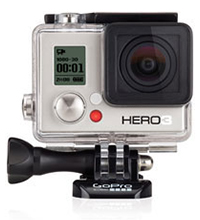My buddies and I recently had the chance to test a GoPro Hero 3 as a primary diving camera on a wreck-diving trip to the Red Sea. Our experiences are summarized below. This is not a complete review — as there are quite a few of those out there — but rather a first-hand accounting of our experience.
Mounting
One of the primary advantages of the Hero 3 camera is the relatively low cost, but the low cost has a price. The base price only covers the camera itself, which is waterproof to about 200 feet. If you’re after a hands-free experience, you’ll need additional equipment. Both GoPro and third-party providers offer a number of mounting options. On this trip, our photographer, Michael, opted for the headband, a three-way elastic strap that allows the user to put the camera on his head above his dive mask. The advantage with this setup should be that wherever the photographer looks, the camera shoots.
Bubble trouble
One of the negative aspects of this setup turned out to be a problem with bubbles. When our photographer exhaled, bubbles tended to get caught under the exterior lens cover of the camera, showing up on the film we shot. The bubbles were particularly visible on the shallow parts of the dive, where the light shining down from the surface reflected in them. It took quite a bit of trial and error to find a placement that minimized the problem, but it never completely disappeared. From time to time, we had to remove the camera from the photographer’s head and give it a vigorous shake to remove the lodged bubbles.
Power Up
With three to four dives per day — most within an hour of the next — battery life quickly became an issue. Luckily, we’d brought along the optional battery pack, which extends the camera’s operating life, and allows for one battery to be charged while the other is in use. This is an optional feature though, so it costs extra.
Steady, steady
Being a human tripod takes some getting used to. The first couple of dives’ material suffered from a good deal of shaking and swerving while our photographer was getting used to having a camera mounted on his forehead. To avoid inducing nausea in your audience, keep your movements slow, steady and as fluid as possible — this takes practice.
The Results
There’s no denying the very good quality of both the Hero 3’s video and still images, which are saved from the video footage. With little option to mount floodlights, the camera was a challenge inside wrecks and on night dives, but you can buy handheld units that allow you to mount lights. Doing so, though, makes the rig so big that there’s little difference between a full-sized underwater camera and a GoPro, which may put off some divers, and definitely defeated our purpose.
The high-quality footage, shot in full HD, does eat up a lot of space, so make sure you have a large memory card. Bring several memory cards or a hard drive for a full week of diving; we ended up with roughly 100 GB of raw material on our week’s worth of diving.
The need for space points to the main advantage of the GoPro Hero 3, especially when mounted in a way where you can forget it’s there. By continuously shooting HD film footage (from which stills can later be sourced) you will never again miss the best shot of the dive while you fumble with your BCD, trying to extract your point-and-shoot.
But the high quantity of raw footage also means that you’ll need a lot of time after your dives to sort and edit the material. In my experience, every hour of finished footage requires five hours of editing work. So divers expecting to strap on a camera and emerge with fantastic, tightly produced underwater films are likely to be disappointed. To get the high-quality material showcased in the advertising material, quite a bit of additional equipment is required, including the items I already mentioned, as well as filters for color compensation at various depths.
Conclusion
Wrap-up

Wrap Up
The idea of spending $200 to $300 on a camera and, right out of the box, shooting underwater film that can rival the best documentaries seems too good to be true, and of course it is. You’ll need additional equipment for the best results, as well as plenty of practice using the camera. Editing after the dive can also be quite time consuming and requires an above-average interest and aptitude in video production; for most dedicated underwater photographers and videographers, this comes as no surprise. That being said, overall the GoPro Hero 3 is a strong player in the field, which can deliver exceptionally high quality footage in a compact, convenient package, at a relatively low cost.

